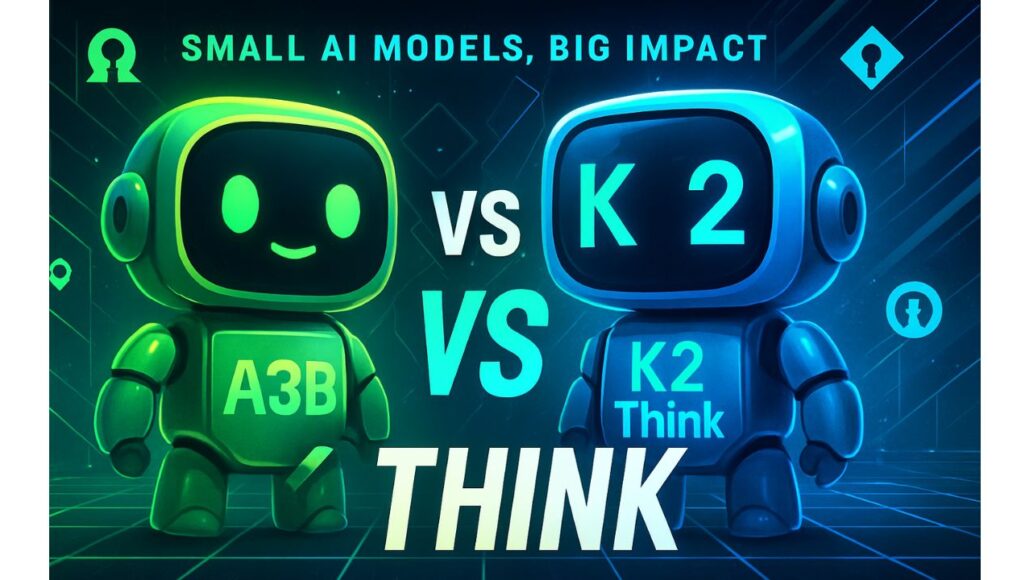There was a time in the AI world when everyone thought that the bigger the model, the more powerful it would be. Means trillion-parameter models only have the potential to build the frontier AI. But now the equation has changed. Two new models – BYU’s A3B and MBZUAI’s K2 Think – has proved that with smart training, efficient design and open-source approach, even the small model have the tendency to do the great work. Both the model have a common message – “Size doesn’t matter anymore, but now the efficiency and planning matters a lot.

🔹 BYU’s A3B Model – Sparse Mixture of Experts Approach
BYU (Brigham Young University) has released the ERA 4.521B A3B, which is called as a A3B in short form. Its name may be a little bit complex but the concept is very simple. This is a Mixture of Experts (MoE) model.
🧠 What is the meaning of MoE?
- A total of 21 billion parameter is available in the whole model.
- But for each token, only 3 billion are active.
- One router decides that which expert to activate.
👉 With this approach, the advantage is that you don’t have to activates the whole network every time, which reduces the computer cost and increases the specialization. Meaning each and every expert develop its own different skill – just like someone is stronger in math, someone in coding or someone in science.
⚡ The A3B Highlights:
- Large Context Window (128K tokens):
It is perfect for the long document or multi-step reasoning. This was achieved through the gradually scaling the rotary position embeddings from 10K to 500K, along with the using the flash mask attention and memory efficient scheduling. - Structured Training Pipeline:
- Stage 1: Text-only pre-training (8K → 128K tokens gradually).
- Stage 2: Supervised fine-tuning (math, coding, science, logic).
- Stage 3: Progressive RL (pehle logic → phir math → phir programming → last me general reasoning).
- Alignment And Stability:
They have used the Unified Preference Optimization (UPO), which prevent the reward hacking and makes the reasoning model more stable. - Tool Use Built-in:
A3B not just only generates the text, but can also call the APIs aur external tools. This means that this model program can easily do the work like synthesis and symbolic reasoning. - Open Source Advantage:
This has been released under the licencee of Apache 2.0. Meaning you can easily download it from the HuggingFace and can use for both the research or commercial product.
👉 BYU says that 3B active parameters per token = sweet spot. This balances between the reasoning power and deployability.
🔹 MBZUAI’s K2 Think – Dense But Extremely Efficient
Now let’s talk about the UAE’s MBZUAI (Mohamed bin Zayed University of AI) and their partner G42’s model K2 Think. You can say that if BYU has taken the sparse approach, then MBZUAI has chosen the dense path.

🧠 Model Backbone:
- Base Model: Quinn 2.532B.
- Total Parameters: 32B.
- But the post-training and inference design is so much powerful that It gives the performance comparable to model like DeepSeek V3.1 (671B) and GPT-OS 120B.
⚡ K2 Think’s Training Pipeline:
- Long Chain-of-Thought SFT:
This model has given step-by-step reasoning example (math, coding, science, general chat). With this, the model not just only learned to answer but also learned the reasoning. - Reinforcement Learning with Verifiable Rewards:
In normal RLHF, there is a risk of reward hacking and to avoid this they had made the Guru Dataset (92K prompts), which contain the verified tasks like math, code, logic, tabular data, and science.- Meaning that model not just get the rewarded on good sounding answer, but for the correct verified answer.
- Inference Time Planning:
When the model generates the answer, first it makes the short plan→ then gives the final answer→ and also check the multiple possible answer through verifiers. This process improves the combo of both accuracy and clarity.
📊 K2 Think AI Benchmark Results – Detailed Explanation
To judge the AI model performance, the benchmark has been used. These benchmark cover different domains like Math, Coding and Science reasoning. And K2 Think has given the result on these benchmark, which is quite impressive and competitive in nature. Let’s understand it step-by-step 👇
🧮 Math Benchmarks
Math benchmarks test that how accurately AI model can solve the complex mathematical problems.
- AIME24 – 90.83
👉 AIME (American Invitational Mathematics Examination) is a tough level math test.
👉 K2 Think’s score comes 90.83 which means it solves the problem with very high accuracy. - AIM25 – 81.24
👉 In this version, little new set of problem is there, and came up with a score of 81.24 – still strong performance. - HMMT25 – 73.75
👉 HMMT (Harvard-MIT Math Tournament) is the world’s toughest high school math competition.
👉 73.75 is the score which means K2 Think handles the question of difficult algebra, geometry and combinatorics type questions very well. - Omnihard – 60.73
👉 This is assumes to be very hardcore benchmark.
👉 60+ is the score shows that this model can handles even the toughest math puzzles.
📌 Summary: The math and reasoning of K2 Think is very powerful, specially in solving the competitive-level problems.
💻 Coding Benchmarks
This benchmark measures that how efficiently this AI model solves the programming and real-world coding tasks.
- Live Codebench V5 – 63.97
👉 This is a updated coding test in which K2 Think has scored 63.97.
👉 This result is better than the advance model like Quen 3 and A22B. - ScyOde – 39.2 on subproblems
👉 ScyOde is a coding challenge benchmark.
👉 39.2 is the score which means this model is able to solve multiple coding subtasks but still there is a scope of improvement.
📌 Summary: Coding performance is stable and deliver better than the competitive models.
🔬 Science Reasoning Benchmarks
Science reasoning benchmarks test how the this AI model apply the scientific knowledge and logical reasoning.
- GPQA Diamond – 71.08
👉 GPQA Diamond is a high-level science QA benchmark whose 71.08 score shows the strong reasoning and knowledge power. - HLE – 9.95
👉 This benchmark test even more advanced logical reasoning.
👉 9.95 is the score show that this model also attempt the difficult science reasoning problems, and here still a lot of improvement is needed..
✅ Final Takeaway
K2 Think’s benchmark results clearly show that:
- It gives top performance in Math and Coding domains.
- Science reasoning is decent but still the need of improvement is require..
- Efficiency and Safety both are balanced and strong.
👉 Overall, K2 think is a fast, safe and problem-solving powerhouse AI model, which can be quite reliable in the real-world applications.
🔑 What Does it Means for the Industry?
- Bigger Models ≠ Always Better:
Trillion-parameter race has come to an end. Now efficiency and smart training will dominate this world. - Open Source Future:
BYU aur MBZUAI have opened released the models – weights, datasets, training code all are available. Which means now freedom for both the research community and startups. - Enterprise Applications:
- A3B – Long context + tool calling → best for the enterprise workflows and multi-agent systems.
- K2 Think – Fast inference + safe reasoning → perfect for the production ready deployments.

🎯 Final Verdict
BYU ‘s A3B and MBZUAI’d K2 Think gives a clear signal that – The future of AI will not be just big but also smarter and more efficient.
- A3B shows that the sparse mixture-of-experts design is sufficient for long context and reasoning.
- K2 Think proves that a 32B dense model can also beat the trillion-size models, if the training and inference are designed properly.
Both this model is the beginning of a new era – where open-source, efficient and transparent AI will going to dominate the future technology.













